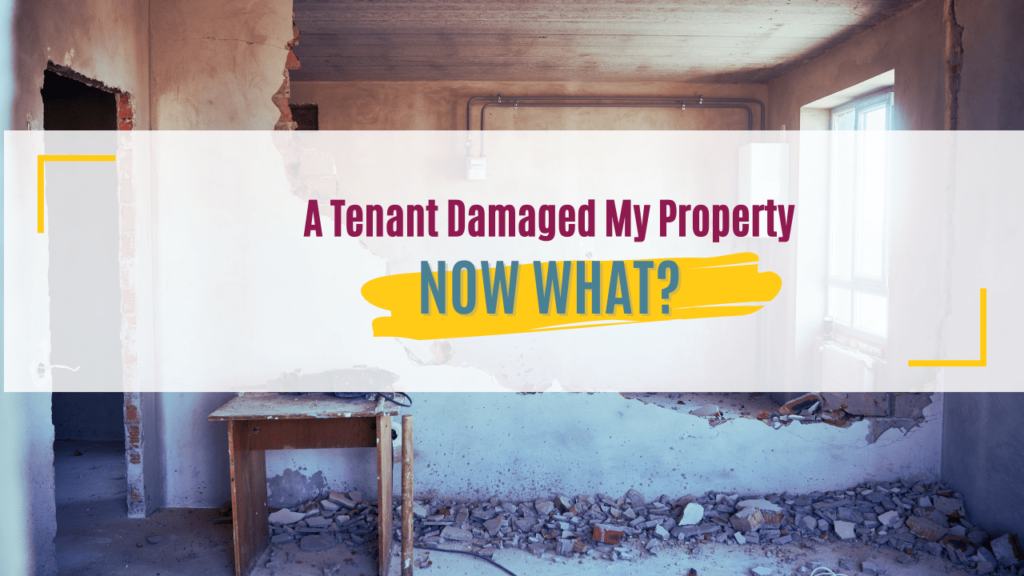
What happens when a tenant damages your Las Vegas rental property?
For starters, you’ll use up as much of the security deposit that’s available in order to pay for the damage. As a landlord, you’re responsible for any costs associated with normal wear and tear. Tenant damage, however, is the responsibility of the residents who caused the damage.
Even if the deposit will pay to repair the damage, walking into your rental property to find a lot of work needing to be done is distressing. Your goal is to get this property back on the market as soon as possible, so you can place a new tenant and have rent coming in again.
Sometimes, you’ll find the property is so damaged that you exhaust the security deposit funds. In our experience as Las Vegas property managers, this is rare. It’s especially unlikely if you have a good relationship with your tenants and you’re committed to walking through the property. You can stay ahead of damage potential in a few strategic ways, which we’ll share at the end of this blog.
First, though, we want to provide some steps that you may want to take when you discover that a tenant has damaged your Las Vegas property.
Review Move-Out Instructions in your Lease Agreement
Before you even evaluate the damage that’s been left behind, review your lease agreement.
The lease will be specific about your tenant’s responsibilities at the end of the lease term and the expectations that you have for how the property will be returned. The lease will validate that tenants are responsible for any damage that occurs outside of general wear and tear. If a tenant or their guest has caused damage, repairing that damage is the responsibility of the tenant.
A strong lease will include information on the penalties a tenant will have to face when damage is done to the property. Your lease should explain that tenants will be required to pay for it; and that the money will be deducted from the security deposit at the end of the lease term. When damage is detected during the lease term, you can ask tenants to pay the bill directly or add the amount to what they pay in rent the following month.
Review your lease so you know how to hold your tenants accountable.
Repairing the Damage and Documenting Costs
Once a tenant has moved out, get inside the property quickly to evaluate what kind of condition the home was left in. You’ll want to make repairs quickly, in the interest of re-renting the home.
Compare your move-in checklist to your findings during the move-out walk through. Put together a list of the work that needs to be done, and separate the things that you’ll take care of (wear and tear that’s expected and normal) from the things that you’ll be charging your tenant for (damage to the property).
You may need multiple vendors to get your property back into rent-ready condition. Whatever you find, make sure you carefully document the damage.
- Take photos
- Take videos, if they tell the story better.
- Make notes.
- Collect estimates from vendors who are likely to make the repairs.
The documentation is critical in case there is a dispute. Once you’ve gathered all the support you’ll need, schedule the work as soon as you can.
Recovering the Tenant’s Security Deposit When Paying for Damages
Before you can make any claim against the security deposit, you have to have your documentation in order and above reproach.
This requires a careful and detailed move-out walk through.
We expect that you would have conducted a thorough walk through before your tenant moved in and documented the condition of the property at that point. Your move-out walk through form will show that damage occurred during the tenancy. It will be easy to compare the condition before possession to the condition after the tenancy. The damage will, hopefully, be clear to you, your tenants, and the courts if it gets that far.
Not only do you want a detailed move-in condition report, you also want a signature from your tenant verifying that the report accurately reflects what they found. This signature demonstrates that all parties agreed to the condition of the property at move-in.
Make the move-out walk through count, especially if there’s a lot of damage. Be detailed.
Once you’ve collected all of the information you need to prove the tenant has damaged your property, you’ll need to put together an itemized list of what was spent to repair that damage. That’s the amount you can lawfully deduct from the security deposit. If the amount that you’ve spent exceeds the amount of the security deposit, you will not return any of that money to the tenant.
Las Vegas rental property owners have 30 days to return a security deposit. If you’re going to keep all or part of that deposit, you need to provide an itemized list of the deductions you’ve made. Follow all the Nevada security deposit rules perfectly. You don’t want to lose a court case because you were a day late in getting that correspondence out.
Damage Exceeding Your Security Deposit
The security deposit is in place to protect you against the cost and risk of property damage. If the amount of damage caused by the tenant exceeds the amount of the security deposit you’ve collected, you can put together a demand letter and send it to the tenant. This letter should include how much is owed and when and how you expect it to be paid.
With your demand letter, include the following:
- Repair invoices from vendors and contractors.
- Receipts of what you paid for those repairs and replacements.
- The lease language that reflects the tenant’s responsibility in this matter.
It’s also a good idea to re-send an accounting of the security deposit that you withheld.
Decide how hard you want to push to get this money paid back. Maybe your tenant feels bad about the damage and is concerned about their reputation and future landlord references. In that case, they might pay you immediately for whatever is owed. More than likely, however, your tenant will ignore your request for payment.
There are steps you can take. For example, you can hire a lawyer or a collection agency to try to recover that money. You can also sue your tenant for the money owed. These options are viable, but you’ll have to be prepared to spend some time and a bit of your own money recovering the funds. Decide if that’s worth it.
Tips to Preventing Tenant Damage
Tenant damage is disruptive, frustrating, and bad for the condition and value of your investment property in Las Vegas. Avoid it, if you can. Here are our best tips for doing that:
- Screen tenants rigorously. Tenant screening typically focuses on financial responsibility and that’s important. You need to know your tenant can afford the rent every month. Make rental history part of your screening process, too. Contact current and former landlords, and ask if any damage was left behind. Ask if the tenants received their full security deposit back at the end of a lease term.
- Collect a security deposit. Under Nevada landlord-tenant laws, a rental property owner can charge a tenant the equivalent of three months’ rent for the security deposit. This is a generous limit, and there aren’t a lot of landlords who will charge that full amount. Most landlords charge one month’s rent for a deposit. That’s a good way to ensure you have enough of a deposit to cover potential damage.
- Conduct periodic walk throughs. The move-in and move-out walk throughs are critical, and most property owners understand that. It’s easy, however, to forget about the importance of routine walk throughs during the tenancy. We recommend getting inside the property at least once a year to conduct a walk through. Write this requirement into your lease agreement and provide your tenants with plenty of written notice before you walk through. Then, use this opportunity to check for any deferred or unreported maintenance. Look for signs of damage or potential lease violations. Tenants are more likely to take care of your property when they know you’ll be walking through. And, you won’t be surprised by excessive damage at the end of the lease term if you’ve been inside the home once or twice during the tenancy.
Partner with Las Vegas Property Managers
 Professional Las Vegas property management comes with a number of benefits.
Professional Las Vegas property management comes with a number of benefits.
Tenant damage is less of a concern. Your management team is tasked with taking care of things like screening, walk throughs, and tenant relationships. We have the experience to ensure your costs are kept down and your property is protected.
We understand that property damage is a real fear and often an unnecessary expense. We’d be happy to share some of our processes and systems for keeping it to a minimum when we’re managing your Las Vegas rental home.
Please contact us at New West Property Management. Our team expertly manages residential rental homes in Las Vegas and throughout Clark County, including Henderson and North Las Vegas.
